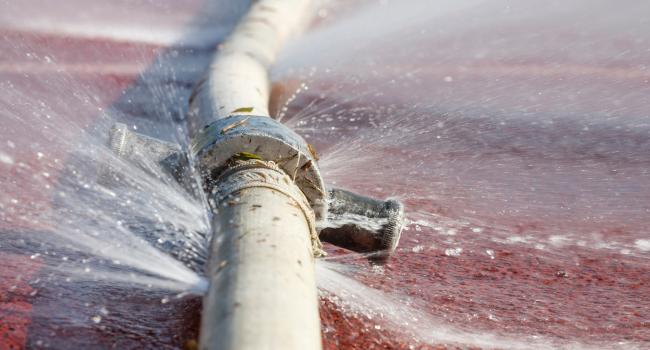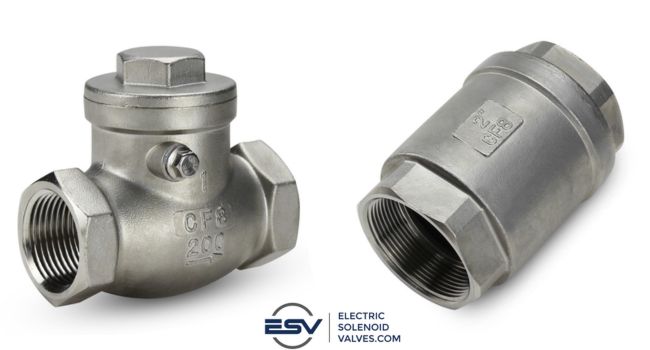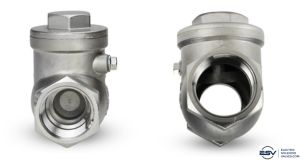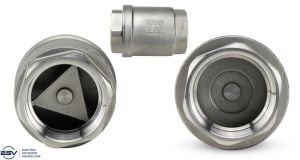Apr 27th 2023
How To Combat Reverse Flow In Piping Systems
Systems conveying fluid media sometimes experience reversed fluid flow. Reverse flow adversely affects the reliability of industrial applications and can negatively impact safety standards. Reverse flow damages flow control devices, pipelines, and adjacent equipment. That demands proactive system design and proper valve sizing to eliminate reverse flow and lower its impacts.
Reversed fluid flow is noticeable even if the piping system is manually operated. Piping systems experience rapid and frequent vibrations. There is media contamination and reduced flow rates in some process sections. Extreme reverse flow over pressurizes the piping system. It causes physical damage to pipes (ruptured parts) and leakages at pipe connections.
Installing check valves is a reliable way to combat reverse flow in process pipelines. These valves should be the right fit for the fluid application. That is:
- The check valves should accommodate system flow rates.
- Check valve construction material must be compatible with the service media.
- The orientation of the check valve should match fluid flow directions.
- Check valves should have appropriate pressure and temperature ratings. Changes in the pressure and temperature of the service media cause fluids to expand or contract. This results in a pressure differential, resulting in reverse flow.
What are the effects of reverse flow in piping systems, and how can we mitigate them?
Consequences of reversed fluid flow

Reverse flow has several consequences. They range from reduced system reliability to legal violations due to non-compliance with industry standards and increased exposure to hazards. Understanding these consequences is critical for developing appropriate mitigation measures to eliminate reverse fluid flow and minimize its adverse impacts.
Cavitation
Reverse flow occurs when a negative pressure zone develops in the pipeline. The pressure drop can be rapid in some instances. The effect of rapid pressure drop is the sudden condensation and evaporation of fluids in a valve’s downstream direction. A slight force is exerted on the service medium as it flows past valves, which creates a miniature low-pressure zone. External forces form cavities in the service medium. It causes temporal vaporization of the service media.
Vaporized fluid begins condensing after leaving the valve zone. Condensation and change of physical state manifest as light noises around valves. Extreme cavitation results in choked flow, limiting flow rates past process valves.
The effects of cavitation are dire over time. Repeated vaporization and condensation around valves increase local stress, resulting in pitting. This is accompanied by rapid wear and tear of valve seals and irreversible damage to internal pipe surfaces.
Leakage and valve slamming
Every piping system has a designated leakage class. Process operators must monitor leakage levels for frequently cycled valves to maximize safety. Pipelines contain check valves that close when the pressure drops below predetermined levels. The check valves close to restrict fluid flow whenever the upstream pressure is lower than the downstream pressure. Reverse flow can occur even when check valves are in place. Although rare, such instances occur when pumping units fail, causing a sharp pressure drop in the piping system.
Sudden pressure drops affect the performance characteristics of check valves. The valves close rapidly — they move from open to closed positions within a shorter time. Rapid changes in valve positions cause the check valve swing or flaps to slam against their seats. Valve slamming generates shockwaves that travel through the pipeline and persist unless frictional forces slow them down.
Valve slamming due to repetitive reversed fluid flow increases stress on the valve seals. It causes rapid deterioration of the seals. The valve begins leaking, releasing service media into the environment. The leakage affects overall flow rates across the system and can compromise the quality of subsequent processes.
Media Contamination
Sanitary and industrial piping systems adhere to different contamination control standards. Service media should possess specific chemical and physical characteristics as it moves through various sections of the piping system. The piping system is designed with fittings and flow control devices to facilitate uninterrupted forward fluid flow. Sometimes, these pipelines experience unprecedented reverse flow.
Reverse flow causes undesirable media contamination, with several cases of contaminated fluids mixing with potable water reported in the past. Such contamination poses a risk to public health. In industrial processes, backflows can initiate unprecedented chemical reactions, severely affecting workplace safety. Chemical media should mix at regulated volumes. However, when backflow occurs, fluids blend unproportionally, compromising the quality of production systems.
System Overpressure
Typical piping systems have sections with varying diameters and multiple pipe fittings to regulate fluid flow. Each component has a recommended pressure and temperature rating to support fluid flow across the piping system. Reverse flow generates a pressure wave directly proportional to the speed of the service media.
The reversed pressure waves interact with the pipe fittings and other piping components. The wave refracts or reflects depending on the pipe orientation as it interacts with piping components. Refraction and reflection of pressure waves result in the formation of sonic waves. The resultant sonic waves are positive or negative. When positive and negative sonic waves converge, they cause pipe vibrations.
The intensity of these vibrations varies from one pipe section to another. Internal pipe pressure builds up as the waves propagate through the piping system. Sometimes the pressure spikes beyond the allowable system pressure. Excess system pressure can cause pipe rupture and noticeable physical damage to pipe fittings and bends.
Mitigating Reverse Flow
Mitigating reverse flow takes more than installing the right set of process valves. It involves:
- Proper system design ensures piping components and fittings have minimal resistance to forward fluid flow.
- Regular and adequate pipe maintenance to enhance the performance of process valves and pumping systems.
- Using the correct grade and size of process valves for media compatibility and optimum responsiveness to pressure variations in the piping system.
Here are proven ways to mitigate reverse flow in sanitary, commercial, and industrial piping systems.
Use the Right Check Valve
Check valves are unidirectional flow control devices — they permit fluid flow in one direction. These valves rely on the differential pressure of piping systems to open or close to regulate flow. The valves open when upstream pressure exceeds downstream pressure. They close if downstream pressure is higher than upstream pressure. There are several types of check valves suited for various applications. They include:
- Swing check valves
- Ball check valves
- Tilting disc check valves
- Silent check valves
- Piston check valves
- Foot check valves
Check valves can close under their weight or due to mechanical force supplied by a spring or a combination of weight and spring action. How do different check valves compare in operation?
Check valves have compact designs for quick responsiveness to pressure changes in piping systems. Some check valves lag before the flapper or disc moves from fully open to a closed position. The gravitational force causes swing and tilting check valves to close whenever a pressure drop exists in the system. The design of conventional check valves relies on lightweight flappers to regulate fluid flow. The lightweight design ensures the valves have low inertia. These flappers also travel the shortest distance to prevent reverse flow. It prevents backflow even in circumstances when the valve might lag. Although conventional check valves are designed to close quickly, they may have poor shut-off characteristics compared to double-check valves.
Ball check valves, different from manual ball valves, can mitigate reverse flow in vertical pipelines. The check valve features a spherical ball within a conical seat. The ball lifts from the valve seat under suitable pressure conditions. The ball returns to its valve seat under gravity or back pressure upon withdrawing fluid pressure. Some piping systems can benefit from foot check valves. These check valves are installed at the inlets of piping systems. These valves have a filtration screen to block debris and foreign matter. The foot check valve prevents reversed fluid flow and has larger ports than the connected pipelines to minimize system pressure losses.
Double-check valves overcome the shortcomings of conventional check valves. The double check valve features two check valves in series. The check valve is spring-loaded. It means the valve moves to a closed position due to spring action instead of its weight. The double-check valve design is to optimize valve redundancy. The second check valve will close to prevent reverse flow should the first one fail to respond. The second check valve forms a tight seal to stop fluids from flowing in the opposite direction. While these check valves are highly effective, they remain unsuitable for hazardous industrial applications. They are popular in domestic water pipelines like small and medium sprinkler-based irrigation systems.
Swing check valves are popular in fluid applications. They are inexpensive and have high flow capacity. This makes them reliable backflow prevention devices in chemical processing plants, HVAC systems, and water and wastewater treatment facilities. Swing check valves allow the flow of fluids when fluid pressure causes the flapper to open in the direction of flow. The flapper swings back to its seat when there is a pressure drop, preventing backflow. Swing check valves are versatile and work in horizontal and vertical pipelines.
Pressurized piping systems are susceptible to water hammers. Such systems benefit from spring check valves. Using swing check valves in pressurized piping systems can increase water hammers and their impacts on process efficiency. Here are why spring check valves are vital for pressurized piping systems:
- The spring force returns the check valve to a closed position irrespective of the pressure differences in the piping system. It provides a tight seal, preventing the reverse flow of the service media.
- The valve opens only when fluid pressure exceeds the valve’s cracking pressure. It ensures positive sealing for the piping system.
- Spring check valves have high pressure and temperature tolerance. They regulate fluid flow for pressurized, high-temperature systems. They also work in vertical and horizontal pipelines.
Spring check valves are suitable for chemical service, industrial gas pipelines, fuel systems, boilers, and public water distribution networks.
Another type of check valve to minimize system vibration and overpressure is the silent check valve. This category of check valves relies on a spring-loaded piston instead of flappers, popular with conventional and swing check valves. The piston has short strokes enabling the valve to respond swiftly to pressure differentials in piping systems. The valve is designed so that the spring controls the axial movement of the piston and prevents the piston from blocking the flow path under normal conditions. Spring action and the short strokes of the piston ensure the check valve operates fast to minimize shockwaves and optimize its efficiency. Silent check valves are suitable for pressurized chemical pipelines, food processing facilities and clean water pipelines.
Install Non-Return Valves
Non-return valves can be used as alternatives to check valves in selected pipelines. They permit fluid flow in one direction. Systems with these valves experience large pressure drops, a factor engineers should consider when sizing piping systems. Non-return valves, like check valves, are available in distinctive designs and sizes. These valves ensure service media flows through pipelines in the desired direction.
Spring-loaded non-return valves are the most popular in the fluid control market. The fluid pressure should overcome the valve’s cracking pressure for the outlet port to open. Spring force causes the valve to close when the fluid pressure drops below the cracking pressure of the valve. Non-return valves are common in heating and cooling circuits where pressure surges are frequent.
Some non-return valves are manually operated. Manual operation increases the probability of backflows in piping systems, making them unsuitable for pressure-sensitive systems, sanitary applications, and chemical handling facilities.
Leverage Power-Assisted Valves
Fluid flow in different facilities places unique demands on piping systems and flow control devices. They also operate at varying pressure and temperature ranges. The criticality of these processes varies, and some can suffer adverse effects when reverse flow occurs. That means process engineers must implement measures to monitor pipelines in real-time and adjust flow control when pumps trip or vacuums exist in piping systems, conditions causing reverse flow.
Consider pipelines designed to circulate water for cooling condensers in power generation plants. These are critical applications that must deliver adequate cooling water around the clock. These systems require advanced valves to regulate fluid flow. They benefit from power-assisted valves. These are primarily actuated process valves and rely on hydraulic, pneumatic, or electric motors to open and close. The power-assisted valves are connected to a programmed control module, enabling them to respond effectively to variations in flow conditions.
Critical fluid applications can leverage power-assisted valves (PAVs) as redundant systems to standard check valves. The conventional check valves shut off when pressure drops exist in the piping system. Sometimes ordinary check valves close within the stipulated timelines. However, due to the pressure conditions in the piping systems, they may fail when shockwaves persist. Systems with PAVs will utilize the redundant system to combat shockwaves and prevent reverse flow. The PAVs are equally beneficial for isolating pipe sections to allow technicians to repair faults like pump failures.
Although using PAVs and conventional check valves forms a dependable redundant system, critical pipelines can experience extended pressure drops. System pressure can drop below the recommended vacuum pressure levels. This increases the possibility of cavitation. It explains why some piping systems have vacuum breakers or air inlets despite installing high-quality power-assisted valves.
Summing Up
Reversed fluid flow in piping systems has multiple negative impacts on fluid applications. Limiting and preventing reverse flow in any application ensures systems are safe and operate effectively. The first step to avoid reverse flow is understanding how reversed fluid flow occurs and its impacts on the piping system. It is beneficial for properly sizing process pipelines and selecting the correct check valves.
Engage an experienced piping design engineer to size and select appropriate flow control devices for your domestic or commercial application. Develop a reliable pipeline maintenance plan. Inspect and repair valves regularly for durable flow regulation. Use high-quality check valves that meet the recommended industry standards.




